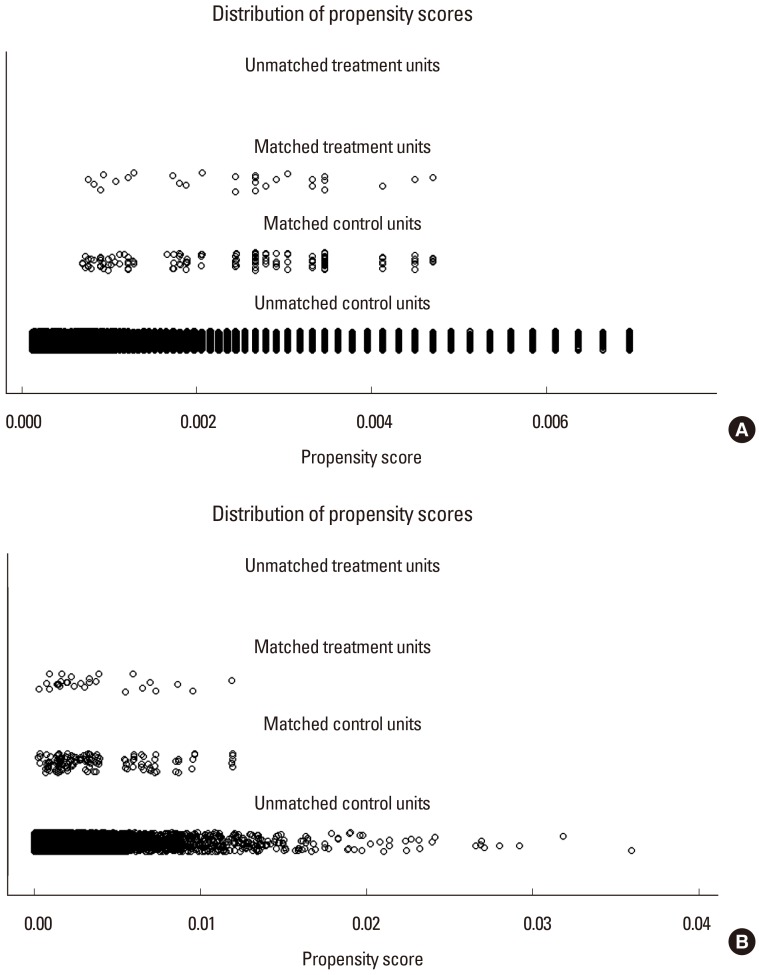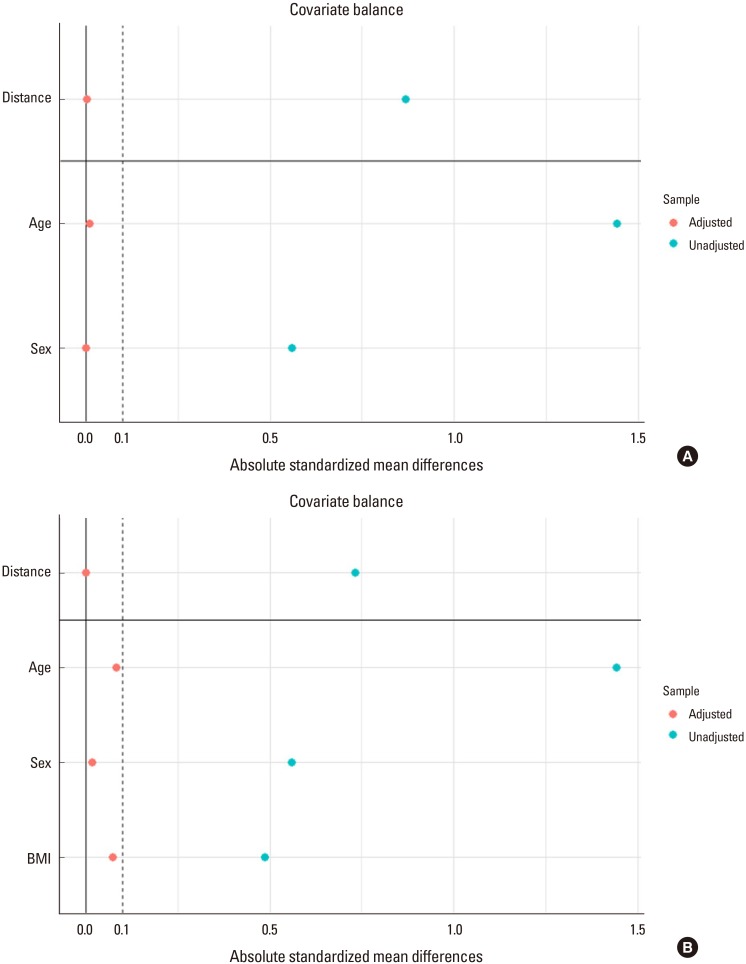J Bone Metab.
2020 Feb;27(1):35-42. 10.11005/jbm.2020.27.1.35.
Characteristics of Appendicular Tissue Components in Patients with Rheumatoid Arthritis
- Affiliations
-
- 1Division of Rheumatology, Department of Internal Medicine, Seoul Paik Hospital, Inje University College of Medicine, Seoul, Korea.
- 2Department of Orthopaedic Surgery, Seoul Paik Hospital, Inje University College of Medicine, Seoul, Korea. cragy0215@naver.com
- KMID: 2471312
- DOI: http://doi.org/10.11005/jbm.2020.27.1.35
Abstract
- BACKGROUND
The purpose of this study was to identify the characteristics of appendicular lean mass (ALM) associated with rheumatoid arthritis (RA) and to analyze appendicular tissue components in patients with RA.
METHODS
We prospectively reviewed of patients with RA who underwent dual energy X-ray absorptiometry in a single center. From data of 28 patients, ALM was calculated. Regression analysis was used to investigate the association between ALM and RA. Using propensity score matching, patients with RA were compared to the control group from 18,698 patients of Korea National Health and Nutrition Examination Surveys data. RA and control group were matched in a 1: 5, respectively.
RESULTS
In regression model, there was significantly negative association between disease activity score and ALM index in patients with RA in unadjusted (β=−0.387, 95% confidence interval [CI], −0.729 to −0.045) and model adjusted for age, sex, and body mass index (β=−0.227, 95% CI, −0.451 to −0.003). In matching with age and sex, the arms fat mass and fat fraction of RA group were significantly lower than that of control group. In matching with age, sex, and body mass index, the ALM index and legs lean mass of RA group were significantly higher than control group.
CONCLUSIONS
Patients with RA have a lower ALM with higher disease activity. In addition, we found that patients with RA had different tissue component in arms and legs compared to general population.
Keyword
MeSH Terms
Figure
Reference
-
1. Brown JC, Harhay MO, Harhay MN. Sarcopenia and mortality among a population-based sample of community-dwelling older adults. J Cachexia Sarcopenia Muscle. 2016; 7:290–298. PMID: 27239410.
Article2. Morley JE, Anker SD, von Haehling S. Prevalence, incidence, and clinical impact of sarcopenia: facts, numbers, and epidemiology-update 2014. J Cachexia Sarcopenia Muscle. 2014; 5:253–259. PMID: 25425503.
Article3. Cruz-Jentoft AJ, Baeyens JP, Bauer JM, et al. Sarcopenia: European consensus on definition and diagnosis: Report of the European Working Group on Sarcopenia in Older People. Age Ageing. 2010; 39:412–423. PMID: 20392703.
Article4. Baker JF, Von Feldt J, Mostoufi-Moab S, et al. Deficits in muscle mass, muscle density, and modified associations with fat in rheumatoid arthritis. Arthritis Care Res (Hoboken). 2014; 66:1612–1618. PMID: 24664868.
Article5. Giles JT, Ling SM, Ferrucci L, et al. Abnormal body composition phenotypes in older rheumatoid arthritis patients: association with disease characteristics and pharmacotherapies. Arthritis Rheum. 2008; 59:807–815. PMID: 18512711.
Article6. Targowski T. Sarcopaenia and rheumatoid arthritis. Reumatologia. 2017; 55:84–87. PMID: 28539680.
Article7. Giles JT, Allison M, Blumenthal RS, et al. Abdominal adiposity in rheumatoid arthritis: association with cardiometabolic risk factors and disease characteristics. Arthritis Rheum. 2010; 62:3173–3182. PMID: 20589684.
Article8. Baker JF, Giles JT, Weber D, et al. Assessment of muscle mass relative to fat mass and associations with physical functioning in rheumatoid arthritis. Rheumatology (Oxford). 2017; 56:981–988. PMID: 28340012.
Article9. Weber D, Long J, Leonard MB, et al. Development of novel methods to define deficits in appendicular lean mass relative to fat mass. PLoS One. 2016; 11:e0164385. PMID: 27723820.
Article10. Aletaha D, Neogi T, Silman AJ, et al. 2010 Rheumatoid arthritis classification criteria: an American College of Rheumatology/European League Against Rheumatism collaborative initiative. Arthritis Rheum. 2010; 62:2569–2581. PMID: 20872595.11. Prevoo ML, van't Kuper HH, et al. Modified disease activity scores that include twenty-eight-joint counts. Development and validation in a prospective longitudinal study of patients with rheumatoid arthritis. Arthritis Rheum. 1995; 38:44–48. PMID: 7818570.
Article12. Chen LK, Liu LK, Woo J, et al. Sarcopenia in Asia: consensus report of the Asian Working Group for Sarcopenia. J Am Med Dir Assoc. 2014; 15:95–101. PMID: 24461239.
Article13. Kweon S, Kim Y, Jang MJ, et al. Data resource profile: the Korea National Health and Nutrition Examination Survey (KNHANES). Int J Epidemiol. 2014; 43:69–77. PMID: 24585853.
Article14. Munro R, Capell H. Prevalence of low body mass in rheumatoid arthritis: association with the acute phase response. Ann Rheum Dis. 1997; 56:326–329. PMID: 9175935.
Article15. Pajak B, Orzechowska S, Pijet B, et al. Crossroads of cytokine signaling-the chase to stop muscle cachexia. J Physiol Pharmacol. 2008; 59 Suppl 9:251–264.16. McDermott MM, Ferrucci L, Guralnik JM, et al. Elevated levels of inflammation, d-dimer, and homocysteine are associated with adverse calf muscle characteristics and reduced calf strength in peripheral arterial disease. J Am Coll Cardiol. 2007; 50:897–905. PMID: 17719478.
Article17. Visser M, Pahor M, Taaffe DR, et al. Relationship of interleukin-6 and tumor necrosis factor-alpha with muscle mass and muscle strength in elderly men and women: the Health ABC Study. J Gerontol A Biol Sci Med Sci. 2002; 57:M326–M332. PMID: 11983728.



